HIP BURSITIS
What is Hip Bursitis?
- Bursae, are small, jelly-like sacs that are located throughout the body, including around the shoulder, elbow, hip, knee, and heel.
- They contain a small amount of fluid and are positioned between bones and soft tissues, acting as cushions to help reduce friction.
- Bursitis is an inflammation of the bursa
Anatomy of the hip joint:
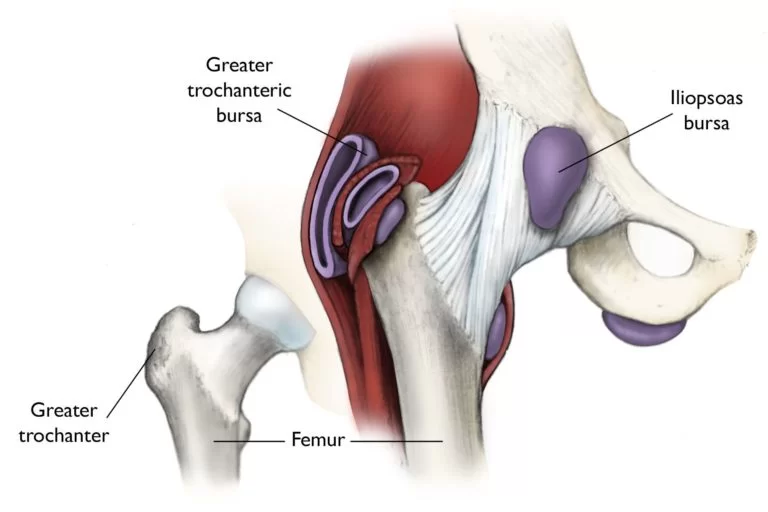
- A bursa is a thin sac of tissue that contains a bit of fluid for the lubrication of the area where the friction occurs.
- The bursa is a normal structure, and the body can even produce a bursa in response to friction.
Types of hip bursitis:
There are mainly two major bursae in the hip that typically become irritated and inflamed:
- Trochanteric bursitis: The trochanteric bursa covers the bony point of the hip bone called the greater trochanter. So the inflammation of this bursa is called trochanteric bursitis.
- Iliopsoas bursitis: The Iliopsoas muscle is located in front of the hip, thus, The bursa located beneath this muscle is called iliopsoas bursa. When this bursa becomes inflamed, the condition is also sometimes referred to as iliopsoas bursitis. It is also called iliopectineal bursitis. This condition is not as common as trochanteric bursitis but is treated in a similar manner as trochanteric bursitis.
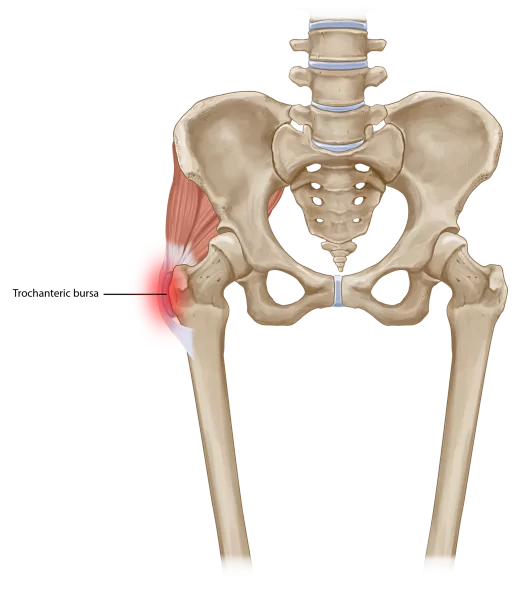
- The pain and tenderness is located at the outer curve of the upper thigh in the trochanteric bursa.
- Whereas, in the iliopsoas bursa the pain is located at the front or groin region.

Signs and symptoms:
- The main sign of trochanteric bursitis is pain at the point of the hip or the groin area.
- The pain usually extends to the outside of the thigh area.
- In the early stages, the pain is usually described as sharp and intense. But Later, the pain may become more of an ache and spread across to the larger area of the hip joint.
- The pain tends to become worse at night, when lying on the affected hip, or when getting up from a chair after being seated for a prolonged period.
Why it occurs? (Causes Of Hip Bursitis)
- Hip bursitis can affect anyone, but it is mainly more common in women and middle-aged or elderly people.
- It is less common in younger people and in men as compared to in women and in elderly people.
- The following causes have been associated with the development of hip bursitis, and the causes are:
Repetitive stress (overuse) injury:
- An overuse injury can occur when running, stair climbing, bicycling, or standing for long periods of time.
Hip injury:
- An injury to the point of the hip can occur when the patient falls onto his hip, bump the hip, or lie on one side of the body for a very prolonged period of time.
Spine disease:
- Spine disease includes scoliosis, arthritis of the lumbar (lower) spine, and some other spine problems.
Leg-length inequality:
- When one leg is significantly shorter than the other one, it affects the way individuals walk and can lead to irritation of a hip bursa. Which later results in hip bursitis.
Bone spurs or calcium deposits:
- These can develop within the tendons that attach muscles to the greater trochanter because of some pathology or degenerative changes. They can irritate the bursa and cause inflammation.
Rheumatoid arthritis:
- This makes the bursa more likely to become inflamed. This is because of the development of bone spurs over the joint surfaces in such conditions. which can irritate and inflame the bursa.
Previous surgery:
- Surgery around the hip or prosthetic implants in the hip can also irritate the bursa and cause bursitis.
DIAGNOSIS
- For the diagnosis of hip bursitis, the doctor performs a comprehensive physical examination, looking for tenderness in the area of the point of the hip or groin area.
- They may also perform additional tests to rule out other possible injuries or conditions.
- These tests can include imaging studies, such as X-rays, bone scanning, and magnetic resonance imaging (MRI).
How can I prevent it? (Preventive Measures)
Although this condition cannot always be prevented, there are things that can be done to prevent the inflammation from getting worse:
- Avoid repetitive activities that put stress on the hips such as cycling, stair climbing, or running.
- Lose weight if needed.
- Get a properly fitting shoe insert for leg-length differences.
- Maintain strength and flexibility of the hip muscles.
Treatment for Hip bursitis:
1. Non-surgical Treatment (Conservative treatment):
The initial treatment for hip bursitis does not involve surgery. Many people with hip bursitis can experience relief with just simple lifestyle changes, And that includes:
The activity modification:
- Avoid activities that worsen symptoms. Initially, it is necessary to take as much rest as possible and put less stress on the hip joint.
Take Nonsteroidal Anti-Inflammatory Drugs (NSAIDs):
- Ibuprofen, naproxen, piroxicam, celecoxib, and others, may relieve pain and control inflammation. However, NSAIDs should be used cautiously and for limited periods. It’s necessary to consult with a physician before the use of NSAIDs as it may have adverse side effects of certain diseases or certain drugs.
Use assistive devices:
Use of a walking cane or crutches for a week or more when it’s needed. Because using assistive devices lessens the stress on the hip joint.
Steroid injection:
- Injection of a corticosteroid along with a local anesthetic may also be helpful in relieving symptoms of hip bursitis. This is a simple and effective treatment that can be done in the doctor’s office. It involves a single injection into the bursa. The injection may provide temporary (months) or permanent relief.
- If pain and inflammation return, another injection or two, should be given a few months apart, may be needed. It is important to limit the number of injections, as prolonged use of corticosteroid injections may likely to damage the surrounding structures.
Physiotherapy treatment:
Physiotherapy treatment is very effective in hip bursitis. It helps to relieve pain and restore hip movement without disturbing the healing process. See physiotherapy treatment below.
2. Surgical Treatment:
- Surgery is rarely needed for hip bursitis. If the bursa remains inflamed and painful after all nonsurgical treatments have been tried, then the surgical removal of bursa is recommended. Removal of the bursa does not hurt the hip, and the hip can function normally without the bursa.
- A newer technique that is gaining popularity is the arthroscopic removal of the bursa. In this technique, the bursa is removed through a small (1/4-inch) incision over the hip. A small camera, or arthroscope, is placed in an incision to guide miniature surgical instruments and cut out the bursa. This surgery is less invasive, and recovery is quicker and less painful.
- Both types of surgeries are done on an outpatient (same-day) basis, so an overnight stay in the hospital is not usually necessary. Early research says arthroscopic removal of the bursa is quite effective.
3. Physiotherapy Treatment:
I.Treatment without Surgery
- Physiotherapy treatment will help individuals return to normal lifestyles and activities. The time it takes to heal the condition varies, but results can be achieved in 2 to 8 weeks or less when a proper stretching and strengthening program is implemented.
- During the first 24 to 48 hours following the diagnosis, the Physiotherapist may advise to:
- Rest the area by avoiding walking or any activity that causes pain.
- Apply ice packs to the area for 15 to 20 minutes every 2 hours.
- Consult with a physician for further services, such as medication or imaging tests.
How physiotherapist will work with the you?
Reduce Pain and Swelling:
- If repetitive activities have caused hip bursitis, The Physiotherapist will help you to understand how to avoid or modify the activities to allow healing to begin. The therapist may use different types of treatments and technologies to control and reduce pain and swelling, which includes the application of ice, heat, ultrasound, electrical stimulation, taping, exercises, and also hands-on therapy, such as specialized massage.
Improve Motion:
- Physiotherapist will choose specific activities and treatments to help restore normal movement in the hip and leg. These might begin with “passive” motion that they perform to gently move your hip joint, and progress to active exercises and stretches that you can do yourself.
Improve Flexibility:
- The physiotherapist will determine if any leg or spinal muscles are tight, help you to stretch them, and also teach you how to stretch them.

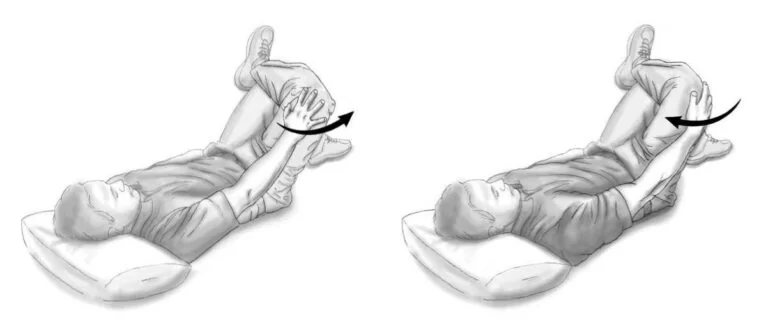
Improve Strength:
- Hip bursitis is often related to weak or injured hip muscles. Some exercises will aid healing at each stage of recovery. Your therapist will choose and teach the correct exercises and equipment to steadily restore strength and agility. These may include using cuff weight, stretch bands, weight-lifting equipment, and cardio-exercise equipment, such as treadmills or stationary bicycles.


Improve Balance:
- Regaining a sense of balance is also important after an injury. The physiotherapist will teach exercises to improve balance skills.
learn a Home-Exercise Program:
- A physiotherapist will teach the strengthening and stretching exercises to perform at home. These exercises will be specific to your needs.
Return to Activities:
- The physiotherapist will discuss the activity goals and use them to set your work, sport, and home-life recovery goals. The treatment program will help you to reach your goals in the safest, fastest, and most effective way possible. Your therapist will teach you exercises, work retraining activities, and sport-specific techniques and drills that match your lifestyle.
Speedy Recovery Time:
- A physiotherapist is trained and experienced in choosing the best treatment and exercises to help you safely heal, return to a normal lifestyle, and reach your goals faster than you are likely to do on your own.
II. Treatment after surgery (Post-Operative Treatment):
Rehabilitation after surgery can be a slow process. Although the time required for recovery is different for each patient. Getting the hip moving as soon as possible is important. However, this must be balanced with the need to protect the healing muscles and tissues.
- Physiotherapists may use ice and electrical stimulation treatments during the first few therapy sessions to help you control your pain and swelling from the surgery. They may also use massage and other hands-on treatments to ease muscle spasms and pain.
- Treatments include range-of-motion exercises and gradual work into active stretching and strengthening. Active therapy usually starts two to three weeks after surgery. So, a therapist may start light isometric strengthening exercises. These exercises work the muscles without straining the healing process of the tissues.
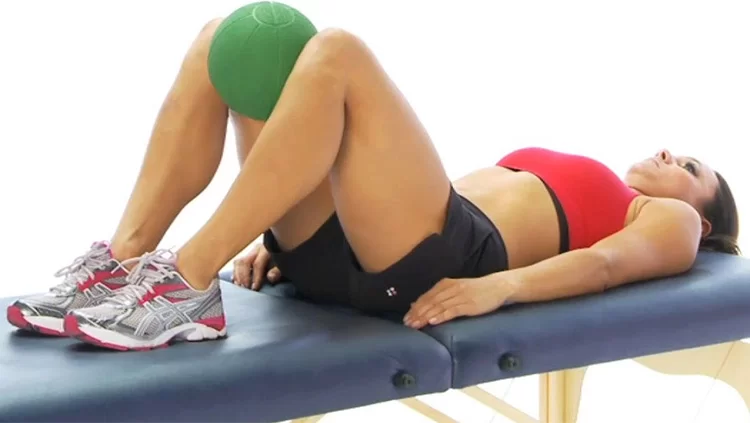

- At about four weeks they may start doing more active strengthening. Exercises focus on improving the strength and control of the buttock and hip muscles. Your therapist will help you retrain these muscles to keep the ball of the femur moving smoothly in the socket.
- Some of the exercises are designed to get the hip working in ways that are similar to your work tasks and sports activities. So, the therapist will help you find ways to do tasks that don’t put too much stress on your hip joint.
- The therapist will also teach you a number of ways to avoid possible problems in the future.
How can I prevent Hip Bursitis?
While there are some situations in which hip bursitis cannot be avoided, there are steps you can take to stop the inflammation from growing worse:
- Stay away from repeated activities that strain the hips.
- If necessary, reduce your weight.
- For variations in leg length, get a shoe insert that fits adequately.
- Preserve the hip muscles’ flexibility and strength.
- To prevent injury, gradually introduce new workouts or activities.
- Don’t spend too much time lying on one side.
Conclusion
Swelling close to your hip joint, known as Hip bursitis, makes it difficult to move without pain. The good news is that resting for a few weeks typically helps. Consult a medical professional as soon as you get hip pain that does not go away after a few days.
Your healthcare professional will assist you in determining the best course of action to ease the pain while your hip recovers. They will also offer advice on how to avoid getting bursitis again.
FAQ
What are the 3 symptoms of hip bursitis?
Symptoms of Hip Bursitis:
Pain is the primary sign of hip bursitis. Hip edema is another indication of hip bursitis. Hip bursitis typically worsens after lying down or sitting for extended periods of time. Climbing stairs is one repeated action that might exacerbate the discomfort.
How do you get rid of bursitis in the hip?
Simple treatments for trochanteric bursitis often involve rest, icing the affected area, targeted stretching exercises, and the use of oral anti-inflammatory drugs. Certain injections could be able to help if these first therapies are ineffective. Surgery is an option for situations that don’t go away.
Does hip bursitis ever go away?
If an infection is not the source of the hip bursitis, it usually heals on its own. Your hip bursitis will recover if you rest the injured joint and keep it safe from additional damage. With the right care, most patients recover in a few weeks.
Is walking good for hip bursitis?
Lying down, sitting still for extended periods of time, and lengthy walks are examples of activities or positions that increase pressure on the hip bursa and exacerbate discomfort.
Can I exercise with hip bursitis?
With focused exercise and recovery from aggravating activities, hip bursitis frequently goes away. Hip-strengthening exercises are commonly prescribed for hip bursitis in order to alleviate symptoms and enhance range of motion.
How should I sleep with hip bursitis?
If you sleep on your side, place a cushion between your knees to keep your hips straight, and try sleeping on your back. If you sleep on your side, sleep on the side that doesn’t pain. Little fluid-filled sacs surround your hip bone and other joints, providing cushioning when the joint moves. Bursae are the name for these sacs.
Can you massage hip bursitis?
As a result, there is less inflammation and strain on the bones and nerves. For treating trochanteric bursitis, massage treatment is more than just a luxury. It offers a transformative chance for those with chronic pain to reduce pain and suffering and resume an active lifestyle.
What is the best sitting position for hip bursitis?
Do not cross your legs. Rather, try to maintain alignment of your feet, knees, and hips. You may do this by getting a wedge cushion, which will enable your knees to be lower than your hips.
What is the best way to heal the bursitis of the hip?
To heal bursitis of the hip fast:
Ice: Every four hours, apply ice packs to your hip for 20 to 30 minutes at a time.
Anti-inflammatory medications: Pain and swelling can be decreased using over-the-counter drugs such as ibuprofen (Advil, Motrin) and naproxen (Aleve), as well as prescription drugs like celecoxib (Celebrex).
Rest
Physical therapy.

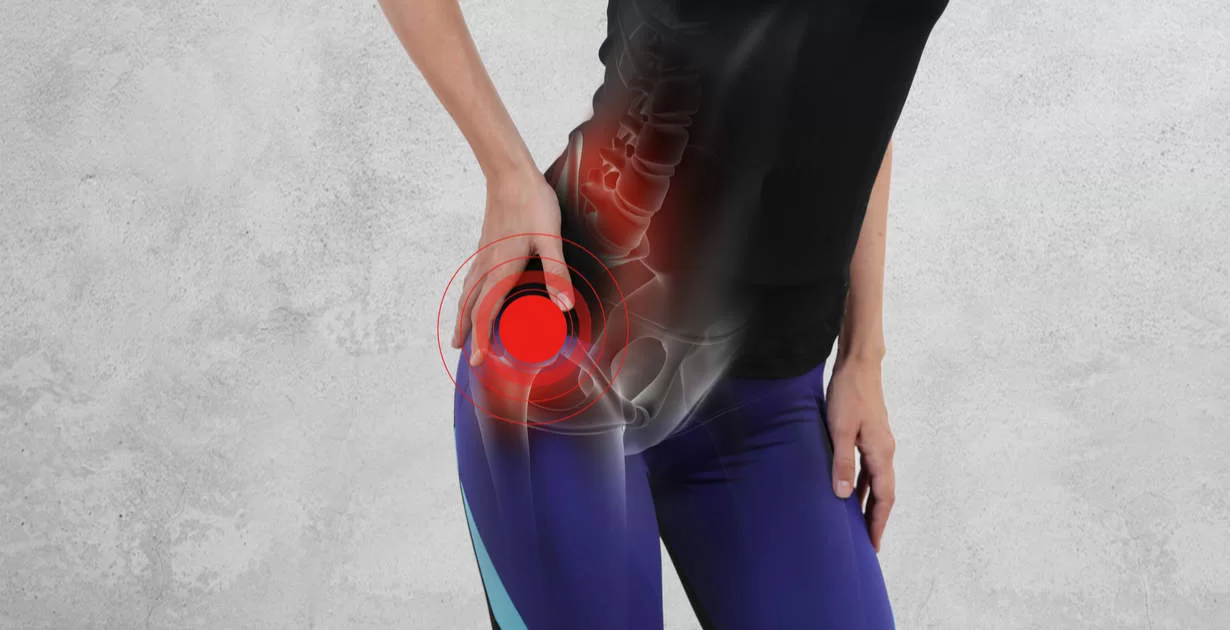
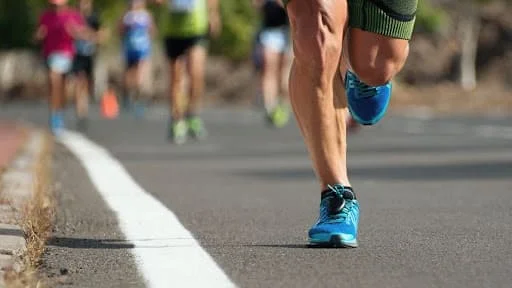

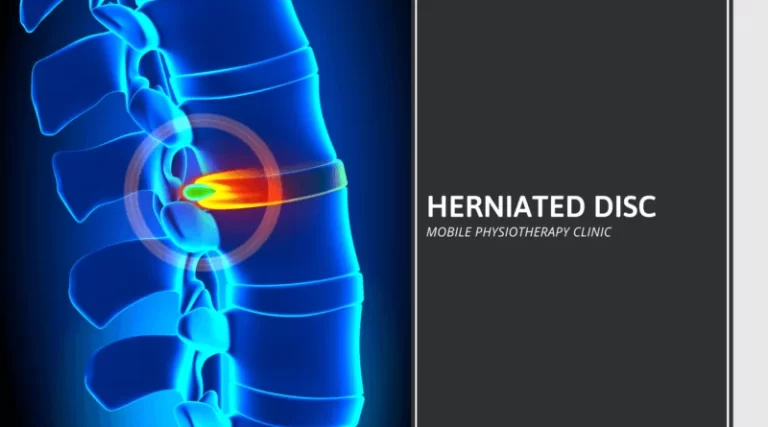
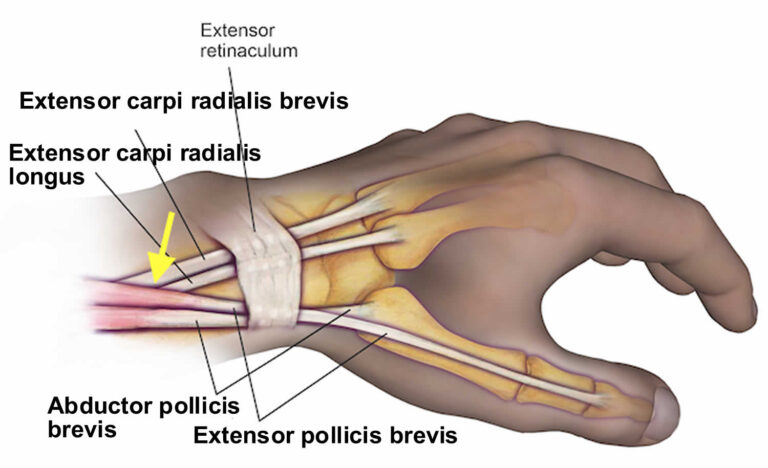
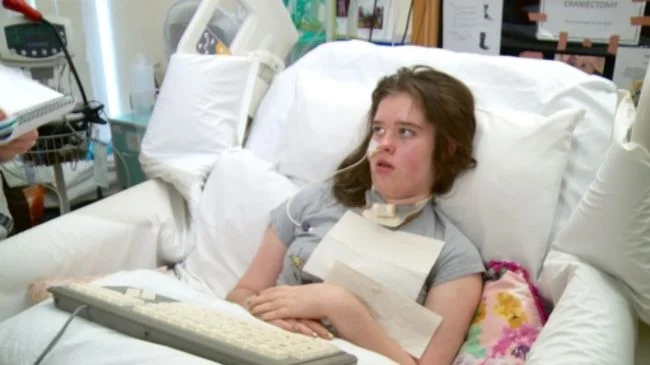

8 Comments